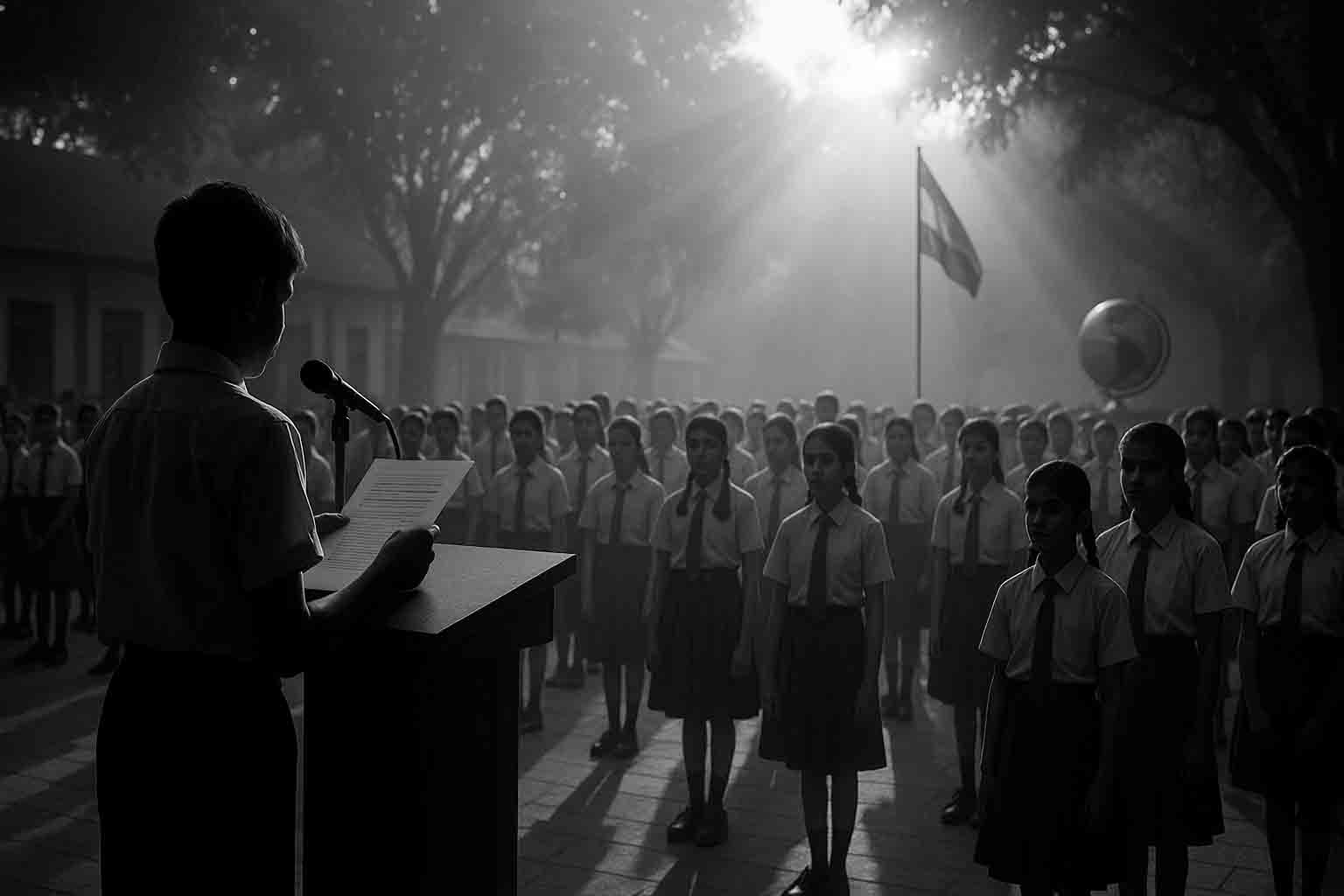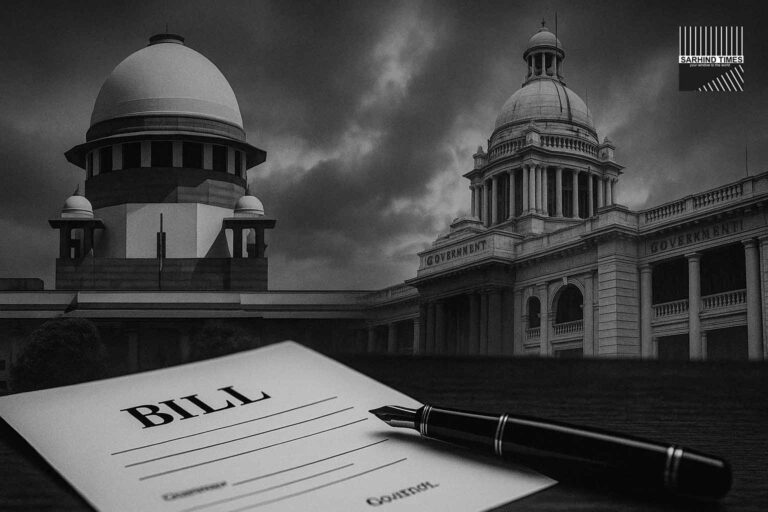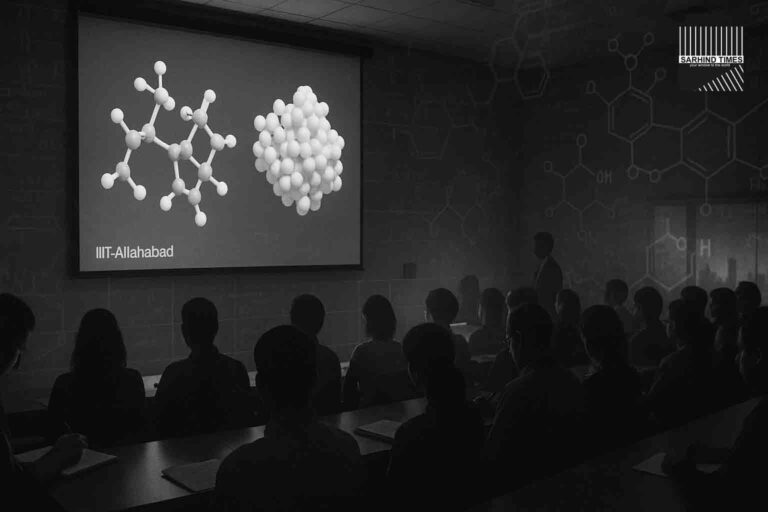New Delhi | October 7, 2025 | Sarhind Times Education Desk
Across classrooms this morning, the sound of student anchors reading headlines echoed with renewed purpose. From aviation safety to world politics, a new generation of learners is waking up to the rhythms of current affairs. The latest “School Assembly Digest” — a curated, student-friendly summary of national and international news — has become a popular resource among schools, linking learning with real-world awareness.
A Morning Tradition Reinvented
For decades, school assemblies in India have opened with prayers, pledges, and the news. Today, that tradition is being reimagined through digital bulletins like the Morning Assembly Digest, designed to connect students to the pulse of civic life in under 10 minutes.
This morning’s edition, shared widely among teachers and students through WhatsApp and school intranets, spotlighted stories that blend education, safety, governance, and global awareness — from a DGCA investigation into an Air India safety incident to India’s upcoming state elections, climate talks, and cultural milestones.
Educators say the initiative is less about memorization and more about media literacy, encouraging students to think critically about what makes news — and why.
“When students read headlines about science, governance, or social issues, they start connecting textbook knowledge to real-world contexts,” said Ritu Mehra, Principal of Tagore International School, Delhi. “That’s the true purpose of an assembly.”
Headline 1: DGCA Probes Air India Safety Incident
India’s aviation regulator, the Directorate General of Civil Aviation (DGCA), launched a review after an Air India flight to the UK reported an unexpected deployment of the Ram Air Turbine (RAT) — a safety device that activates during power loss.
Although no passengers were harmed, the incident drew attention to aircraft maintenance protocols and flight safety standards.
The DGCA has sought reports from Boeing and the airline’s engineering division.
For students, it’s a lesson in aerodynamics, emergency preparedness, and accountability — bridging physics, technology, and ethics.
“Such stories can spark curiosity about aviation careers or safety engineering,” said Aarav Gupta, Class X student, Mumbai. “We read it out as our science headline today.”
Headline 2: Election Watch — Democracy in Action
The digest also highlighted India’s assembly election updates — a practical civics lesson in democracy. From Haryana to Maharashtra, election commissions have begun preparing voter lists, deploying EVM checks, and enforcing model codes of conduct.
The feature explained how elections strengthen democratic participation and how the right to vote aligns with Fundamental Duties in the Constitution.
Students often quiz one another on the Election Commission’s role, fostering civic consciousness from an early age.
“When I read about voter awareness, I imagine myself voting at 18,” said Kavya Nair, a Class IX student from Gurugram. “It feels like a future responsibility.”
Headline 3: Global Affairs — France, U.S., and Climate Talks
The international section brought attention to global developments:
- France is debating climate funding policies after record heatwaves.
- The United States faces renewed discussion on student loan reforms.
- UN climate negotiators have urged youth inclusion at COP29.
Teachers used these stories to explain how international relations and environmental studies intersect.
“News about other nations helps us realize how interconnected the world is,” said Rajveer Singh, a student reporter at a Delhi school newspaper. “We feel part of something bigger.”
From Newsrooms to Classrooms: How the Digest Works
The School Assembly Digest is compiled daily by education journalists, reviewed by teachers for classroom appropriateness, and distributed as a one-page bulletin with:
- 3–5 concise headlines (National + Global + Science + Civic)
- Simple language summaries (under 100 words)
- A “Fact Corner” or “Question of the Day”
- A “Word of the Day” aligned with vocabulary development
The format allows schools to integrate current affairs without politicization. Many institutions pair it with student-led presentations, quizzes, or brief discussions.
Connecting Curriculum with the World
Educators note that such curated content reinforces subjects like:
- Civics: Understanding governance, rights, and duties
- Geography: Mapping global events and climate issues
- Science: Linking theory with application through news in space, health, or technology
- English & Communication: Enhancing reading and summarization skills
“Students not only read the news—they interpret and explain it,” said Dr. Indu Bhatnagar, educational consultant. “It’s a modern form of the Socratic method.”
A New Role for Media Literacy in Schools
Media literacy—once an optional enrichment—has now become central to 21st-century education.
UNESCO’s Global Media and Information Literacy Framework encourages educators to teach children to verify sources, identify bias, and engage responsibly online.
The School Assembly Digest aligns with this mission, filtering credible sources like The Indian Express, NDTV, BBC, and Reuters into short, factual segments.
“Students are flooded with social media narratives. These bulletins teach them to discern information from misinformation,” said Anjali Sharma, a media studies teacher at a CBSE school in Jaipur.
Science and Space: From Mars to Microbes
Today’s “Science Corner” highlighted NASA’s Artemis program and India’s Chandrayaan-3 rover findings on lunar minerals — linking global and national scientific endeavors.
In classrooms, teachers used these to discuss space exploration ethics, STEM careers, and India’s rise as a spacefaring nation.
Students expressed fascination at how quickly new discoveries enter public knowledge — and how India now shares space headlines with the world’s biggest agencies.
Culture & Sports: Beyond the Headlines
The digest doesn’t stop at hard news. Each edition ends with cultural and sports highlights:
- India Women’s Cricket Team beating Pakistan in Colombo
- World Teachers’ Day reflections on classroom heroes
- Music and arts festivals reviving post-pandemic community life
This section fosters empathy, diversity, and balance — teaching students that news is not just about crisis but also creativity, courage, and culture.
Schools Respond: Integrating News into Assembly Culture
Schools across NCR and other metros are incorporating these digests into their morning rituals.
At Delhi Public School, Rohini, students rotate as “news presenters,” each responsible for one domain: national, international, science, and fun fact.
At Shishukunj International, Indore, assemblies begin with a “thought for the day,” followed by news and quiz, ending with “positive headlines” that spotlight achievements and innovations.
“We want students to see themselves as citizens-in-training,” said Principal Vinod Kapoor. “A student who reads the news will one day write it.”
Why It Matters: The Pedagogy of Awareness
Education experts argue that awareness is as vital as academics. Knowing the world’s problems and progress shapes responsible adulthood.
- Critical Thinking: Students learn to question, not memorize.
- Empathy: Understanding global challenges builds compassion.
- Confidence: Speaking in assemblies hones communication and leadership skills.
- Relevance: Classroom lessons find real-world parallels.
“Current affairs bring life to textbooks,” said Dr. Pallavi Nanda, education psychologist. “It’s experiential civics at its best.”
Digital Integration: News Apps and Audio Bulletins
Some schools now use voice-assistants and podcasts to make the experience more immersive.
Apps like Newsahoy EDU and EdConnect Radio let students stream daily 5-minute bulletins with quiz prompts.
AI-powered summaries, curated by teachers, personalize content by grade level — ensuring primary students get simplified versions while seniors tackle policy and economy stories.
“News shouldn’t intimidate kids—it should inspire them,” said Ashish Rawat, co-founder of a learning app that syndicates classroom news.
Quiz Clubs & Debating Societies Rise Again
The renewed focus on current affairs has revitalized co-curricular clubs.
Schools report growing participation in:
- Quiz leagues like BrainBusters and Young Chronicles
- Debates on governance and ethics
- Mock United Nations (MUN) programs on climate change, AI, and equality
These platforms merge academic skills with civic reasoning — preparing students for informed citizenship and public discourse.
Teachers as Curators of Context
Behind every assembly bulletin lies a teacher’s unseen labor—reading, fact-checking, simplifying, and contextualizing.
In many schools, English and Social Studies departments collaborate to draft bulletins, ensuring balanced content that avoids bias or misinformation.
“The idea is not to preach, but to provoke curiosity,” said Priya Joseph, head of English at a Chennai school. “If a student goes home and looks up a news topic, we’ve succeeded.”
Parents Weigh In: News at the Breakfast Table
Parents, too, are rediscovering current affairs alongside their children.
Home routines now include discussions on science discoveries or national events read aloud in assemblies.
“Instead of random YouTube videos, my daughter now tells us about aviation safety and elections,” said Meera Iyer, parent of a Class 8 student. “It’s the best kind of dinner conversation.”
The Global Classroom: Comparing Models
Countries like Finland, Japan, and Singapore already embed news education into school curricula.
Students there analyze headlines for language structure, data interpretation, and ethical framing.
Indian schools adopting the assembly digest model are therefore aligning with global best practices in civic competence and literacy.
Challenges: Balance and Sensitivity
Teachers admit it’s tricky to select news that’s informative yet age-appropriate.
Stories involving conflict, politics, or tragedy require careful framing.
“We avoid sensationalism,” said Principal Reena Arora of a Gurgaon school. “Children deserve truth—but with context and care.”
This approach models responsible journalism within education—critical in a time of misinformation.
The Bigger Picture: News Literacy as Nation Building
When a 10-year-old confidently explains the DGCA’s role or the Election Commission’s process, it’s not just awareness—it’s empowerment.
Educationists believe that nurturing curiosity about civic systems strengthens democracy itself.
“Today’s informed student becomes tomorrow’s informed voter,” noted Professor Ashok Deshmukh, policy advisor at NCERT. “Every assembly reading is an act of citizenship.”
Looking Ahead: The Future of the Morning Bulletin
The School Assembly Digest model may soon expand nationwide, possibly integrated into NCERT’s New Education Policy (NEP 2020) framework under “Experiential Learning.”
Pilot programs are being designed where students create their own mini bulletins, integrating language, data, and digital tools.
By 2030, assemblies may feature student journalists reporting from school corridors, AI-generated infographics, and bilingual news capsules — blending tradition with technology.
Conclusion: A Generation That Reads, Thinks, and Leads
From DGCA probes to election updates, today’s assembly bulletins remind us that classrooms are not cut off from current affairs—they are gateways into them.
Each morning headline is more than a report; it’s a rehearsal for informed citizenship.
When students step up to the mic and say, “Good morning, here is your news for today,” they aren’t just reading—they’re learning to lead.
#Education #MorningAssembly #CurrentAffairs #Students #DGCA
#NewsLiteracy #SchoolLife #Civics #Learning

























+ There are no comments
Add yours